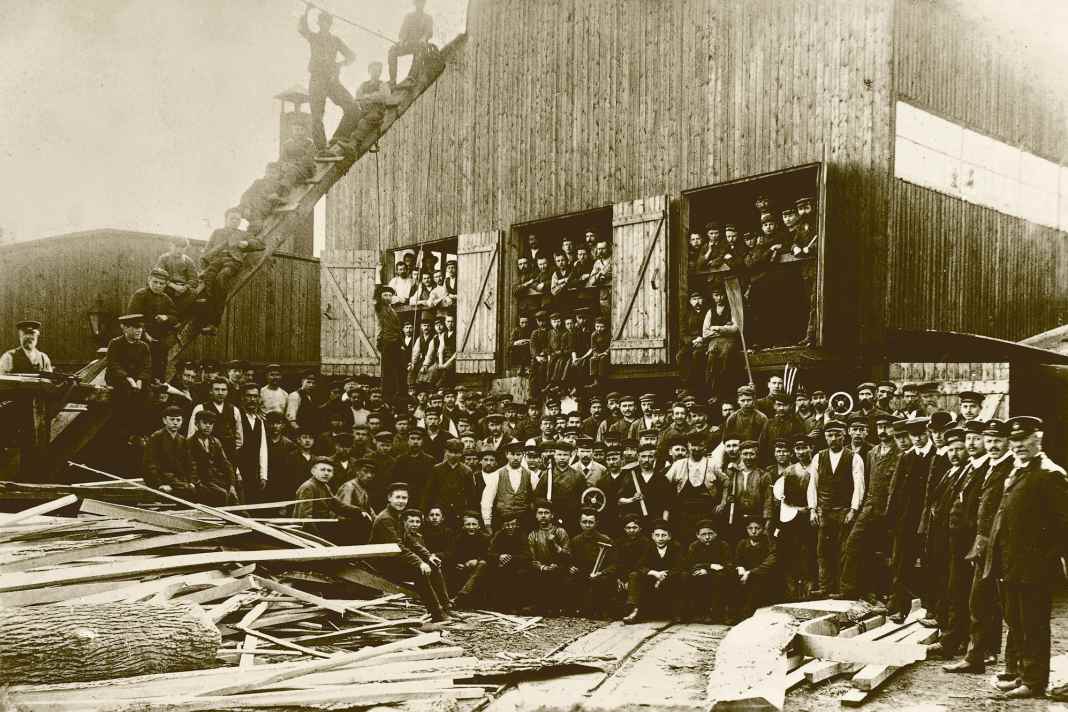





When Friedrich Lürßen founded the Lürssen company in 1875 at the age of just 24, he quickly cemented his reputation as a designer of exquisite rowing and motor boats. The early Lürssens were no larger than today's tenders and were built with great care from the finest woods. Solid craftsmanship was the basis for success. Friedrich Lürßen - with internationalisation, the Eszett disappeared from the company name - was personally involved from the first cut to delivery and greeted his team at the gate every morning. Although born in Lemwerder as the son of a boat builder, he opened his business on the opposite side of the Weser in Bremen-Aumund.
Business was going well for Friedrich Lürßen. The small shipyard blossomed into a top address not only for competitive rowing boats, but also for floating vessels of all kinds: workboats, motorboats, lifeboats and more. After Gottlieb Daimler invented and patented the petrol engine for a "horseless carriage", he approached Friedrich Lürßen and asked him to build the first boat with an engine. He immediately set to work and completed the world's first motorised boat, the "Rems", in the summer of 1886.
Bang on the money: "Rems" was the world's first motorboat
Ten years after the company was founded, Friedrich Lürßen carried out pioneering work that also laid the foundations for today's superyacht industry. The "Rems" was a six-metre-long masterpiece with strikingly beautiful lines, beautifully finished and, above all, equipped with the technical innovation of a Daimler engine. The output of the modified unit: 1.2 kilowatts. During the first "river trials" on the Neckar, Gottlieb Daimler went to great lengths to avoid attracting attention. The wooden sloop looked extremely attractive thanks to its slim bow, which merged into a wide centre section and ended in the well-shaped classic stern. The noise level did not suit "Rems" at all. Local residents prevented the explosion-generating engine from reaching the shore near Daimler's Stuttgart workshop.
Undeterred and typical of the young inventor, Gottlieb Daimler installed copper wires and insulators to make the motor look like an electrical system. The illusion worked. The world's first motorboat was successfully tested, and the excited locals capitulated. The delivery of the six metre long "Rems" paved the way for further motorboats. Lürßen and Daimler enjoyed a long friendship and a thirst for development, which resulted in ever larger and more powerful vessels.
Read more about this:
At the turn of the century, Lürssen motorboats were an integral part of German inland waterways. At 19 metres in length, the "Maria-Augusta" was one of the largest formats of its time. It had an elegant hull, a classic canoe stern and a superstructure with an integrated wheelhouse - a novelty at the time. Daimler built a 20-kilowatt engine for her, which enabled a comfortable cruising speed of nine knots.
Innovations from Lürssen became the yacht standard
The motorboat itself was the first in a long series of innovations that Lürssen introduced and which have since become the industry standard. In 1997, the world's first energy-efficient hybrid drive was installed on board the 96 metre long "Limitless". In 2002, the company led the way in the development of underwater exhaust systems that drastically reduce back pressure and noise.
Shortly afterwards, in 2005, Lürssen delivered the 90 metre long "Air" (now "Ice"), the world's first yacht with pod propulsion. In 2009, the Bremen-based shipbuilding company introduced a wastewater treatment system based on membrane technology, which was first used on the 60-metre yacht "Arkley" (now "Caipirinha") and is now standard on many yachts. The 147.52 metre long "Topaz" (now "A+") was the first yacht with a ballast water treatment system.
Lürssen has also patented an innovative exhaust gas aftertreatment system that drastically reduces nitrogen oxide (NOx) emissions without compromising on space, weight, noise or vibrations. SCR technology has also been a standard feature of every new build since 2016. Five years ago, Lürssen launched Tesumo on the market together with Wolz Nautic. The sustainable teak alternative has been available to the industry ever since and can be found on the helideck of one of Lürssen's most recent deliveries, the 142 metre long "Dragonfly".
Focus on the CO₂-neutral future of yachting
In keeping with its anniversary year, Lürssen is preparing the next step towards a CO₂-neutral future for yachting: the 114 metre long "Cosmos". Similar to her 139-year-old predecessor "Rems", "Cosmos" was commissioned by a technology-enthusiastic customer. With its innovative methanol-powered fuel cell system, "Cosmos" should be able to stay at anchor for 15 days or travel 1,000 miles at slow speed - completely CO2-neutral.
"We have made enormous progress in achieving an important goal of mine," says shipyard boss Peter Lürßen. "It was my great-grandfather who built the first motorised boat in 1886, paving the way for yachting as we know it today. My dream is to build the first yacht without an internal combustion engine and thus usher in a new era." Lürssen dedicated much of the 20th century to naval and merchant shipbuilding, and it was not until 1988, under the leadership of Peter Lürssen, that the company established its own yacht division.
Since then, the Bremen-based company with around 2,000 employees has built 70 custom yachts with a total length of more than 6,500 metres. 35 of the world's 100 largest yachts come from Lürssen halls at six locations in northern Germany. These include the 180.61 metre long "Azzam", the 156 metre long "Dilbar" and the 126.2 metre long "Octopus" - the longest yacht in the world, the most voluminous yacht and the first explorer.
Even though Lürssen has worked its way up to become the global market leader in the gigayacht segment over the last three decades, the shipyard is concerned with other values, as Peter Lürssen makes clear: "We are not out to build the biggest yachts, but the best yacht for every owner. Our customers choose us because of our technical excellence, our willingness to innovate and our determination to fulfil their wishes - no matter how unattainable they may seem."

